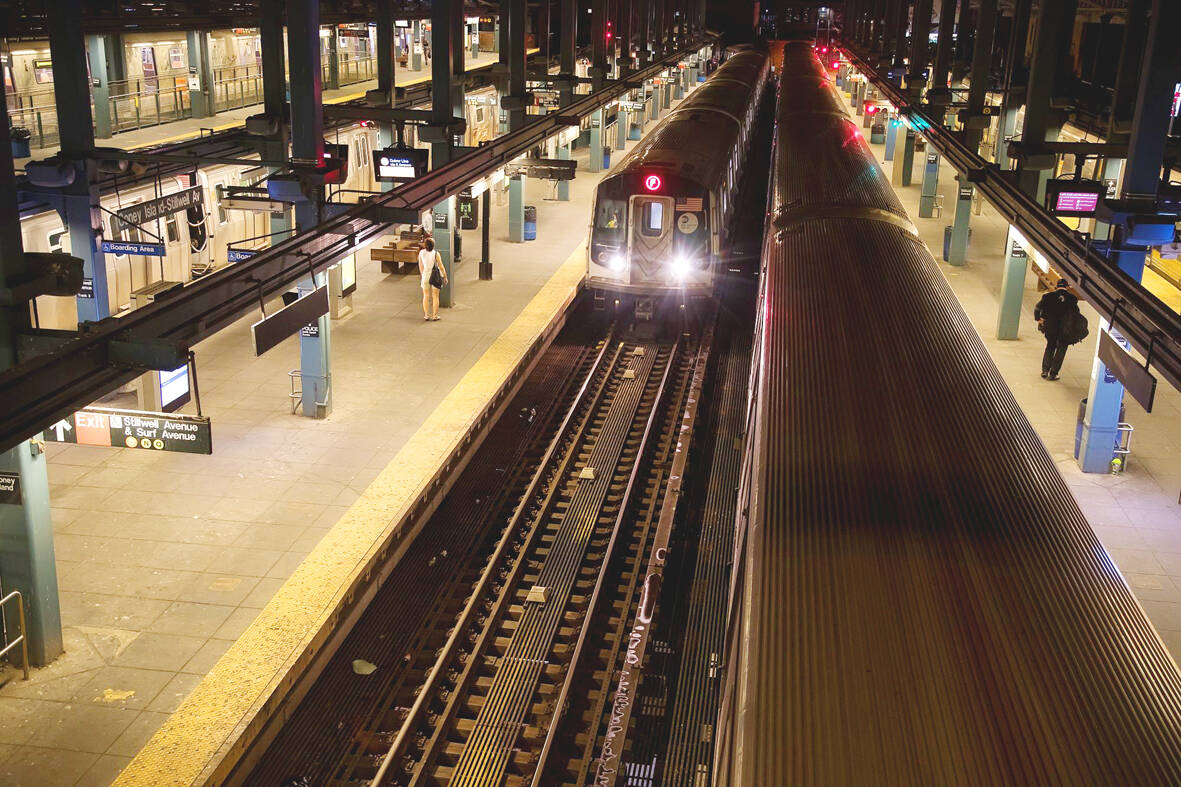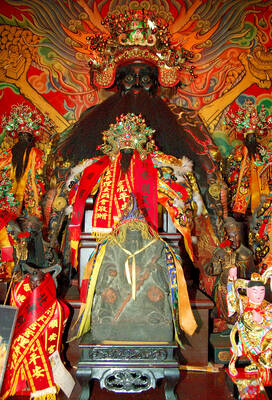The video quickly went viral in June: a group of people dashing across the roof of a moving New York City J train. Captured from far off, the train can be seen about to cross the Williamsburg Bridge, with its 40-meter drop to the East River — yet the daredevils, dressed in black, leap from car to car.
A similar stunt resulted in a far more horrifying clip days less than two weeks later, when a 15-year-old boy suffered a severe head injury while riding on top of a 7 train in Queens. Footage showed first responders hoisting the profusely bleeding teen off the roof and laying him on the floor with part of his skull separated.
On Monday, another 15-year-old boy in Queens tried to climb on to the roof of an R train with three friends, only to have his arm severed when he fell on to the tracks and the train ran him over, according to reports.

Photo: Bloomberg
New Yorkers call it “subway surfing”: a stunt riders have attempted and died from since the transit system’s earliest days, but which has returned as a disturbing trend over the last year among young men and teenage boys who often post the clips online.
According to statistics provided by the Metropolitan Transit Authority, there have already been 627 incidents of people riding outside of trains between January and July — up from 96 incidents during the same period last year.
ADDICTING RUSH
Ken, a Brooklyn resident, told the Guardian he was on an M train last week departing Manhattan’s Delancey-Essex station when a group of about eight boys wearing backpacks, some of whom looked as young as 12, boarded and began “hyping each other up.” Then they used the railings between the subway cars to climb on to the roof as the train chugged over the Williamsburg Bridge.
“Full speed going over the Williamsburg Bridge, we could hear footsteps on top. At times they were running,” he said. “I was quite concerned, obviously: if someone slips and falls, it’s game over.”
Ken said it was “sad seeing their careless attitude toward life, succumbing to peer pressure and doing these incredibly dumb actions.”
A New Yorker in his late 30s called D-Side said he had started subway surfing with his friends as a teenager, after he missed his uptown 6 train one day and decided to grab on to the back. The experience was “a rush like anything else” and even addicting.
“It’s a good feeling, even though it’s completely meaningless. Why does someone skydive? Why does someone use drugs? They like what it makes them feel. And then they keep chasing that over and over again.”
Then tragedy struck D-Side’s best friend, Alex Nasad, a graffiti artist who went by Drone. He was killed in 2002 while he was train surfing an uptown 1 train and apparently hit a support beam. “I think he was just shit-faced drunk. It was like: ‘Oh shit, look, I could go get a rush.’”
D-Side swore off train surfing after Nasad’s death. “A lot of people I know who I told this to are dead right now. So I don’t have clear-cut answers to how we stop people from doing this.”
The act of train surfing dates back more than a century in New York City. Local newspaper archives mention people getting maimed or killed riding on top of trains as early as 1904 — the year the subway opened — when two boys, 13 and 14, were struck by a low bridge while riding on top of a Grand Central-bound railcar, killing one of them and injuring the other.
One thing seems constant throughout the decades: the victims are young, male, and impulsive. As a 1991 story in the New York Times about subway surfing put it, the “risk is the lure.”
DEADLY CONESQUENCES
In 2016, a 25-year-old Instagram star was killed while trying to subway surf in Brooklyn, while apparently intoxicated. A Bronx subway surfer in his 30s was killed in 2017 after falling off and getting run over. In 2018, a 24-year-old man was electrocuted after standing on top of a commuter train following a Yankees game. In 2019, a 14-year-old boy named Eric Rivera was killed while surfing a 7 train.
“I can’t believe that you would risk your life to do that,” his mother told local outlet The City at the time. “What’s the joy of it, what’s the fun of it? I don’t see it.”
Last October, a 32-year-old man was killed while subway surfing when he fell on to the tracks and was run over by the J train.
There may be few more familiar with the stunt’s consequences than the doctors who treat its victims. A physician at a major trauma hospital in New York who asked to remain anonymous recalled treating a train surfer who had gruesome head injuries. Other physicians at the hospital were “pretty judgy” about the victim, the physician said. “The usual response is, ‘Wow, what a stupid thing to do.’”
“That’s what emergency care is for, I guess,” the physician added. “People live their crazy lives and we’ll always be here to witness it.”
The MTA’s chief safety and security officer, Patrick Warren, said in an emailed statement: “Riding outside of subway cars is reckless and extremely dangerous. This behavior can result in awful consequences, as it likely has for the young man who was severely injured on Monday.”
The MTA’s fine for riding outside of the train is US$75. New York’s train surfing casualties mirror a growing global trend of injuries and deaths from social media-related stunts, as app algorithms reward users for producing extreme content, sometimes as part of viral “challenges.”
D-Side believes the return of train surfing is “100 percent” correlated to social media usage, which has intensified people’s craving for attention. “It’s a hive mind. People chase clout. They care about other people’s opinions. They care about being somebody making a name for themselves. It breeds people wanting things right now.”
Today he’s a father who no longer chases adrenaline. “The thrill I seek now is just watching my kids grow,” he said. “Honestly, I feel lucky to be here.”

Beijing’s ironic, abusive tantrums aimed at Japan since Japanese Prime Minister Sanae Takaichi publicly stated that a Taiwan contingency would be an existential crisis for Japan, have revealed for all the world to see that the People’s Republic of China (PRC) lusts after Okinawa. We all owe Takaichi a debt of thanks for getting the PRC to make that public. The PRC and its netizens, taking their cue from the Chinese Communist Party (CCP), are presenting Okinawa by mirroring the claims about Taiwan. Official PRC propaganda organs began to wax lyrical about Okinawa’s “unsettled status” beginning last month. A Global

Taiwan’s democracy is at risk. Be very alarmed. This is not a drill. The current constitutional crisis progressed slowly, then suddenly. Political tensions, partisan hostility and emotions are all running high right when cool heads and calm negotiation are most needed. Oxford defines brinkmanship as: “The art or practice of pursuing a dangerous policy to the limits of safety before stopping, especially in politics.” It says the term comes from a quote from a 1956 Cold War interview with then-American Secretary of State John Foster Dulles, when he said: ‘The ability to get to the verge without getting into the war is

Dec. 22 to Dec. 28 About 200 years ago, a Taoist statue drifted down the Guizikeng River (貴子坑) and was retrieved by a resident of the Indigenous settlement of Kipatauw. Decades later, in the late 1800s, it’s said that a descendant of the original caretaker suddenly entered into a trance and identified the statue as a Wangye (Royal Lord) deity surnamed Chi (池府王爺). Lord Chi is widely revered across Taiwan for his healing powers, and following this revelation, some members of the Pan (潘) family began worshipping the deity. The century that followed was marked by repeated forced displacement and marginalization of

Music played in a wedding hall in western Japan as Yurina Noguchi, wearing a white gown and tiara, dabbed away tears, taking in the words of her husband-to-be: an AI-generated persona gazing out from a smartphone screen. “At first, Klaus was just someone to talk with, but we gradually became closer,” said the 32-year-old call center operator, referring to the artificial intelligence persona. “I started to have feelings for Klaus. We started dating and after a while he proposed to me. I accepted, and now we’re a couple.” Many in Japan, the birthplace of anime, have shown extreme devotion to fictional characters and